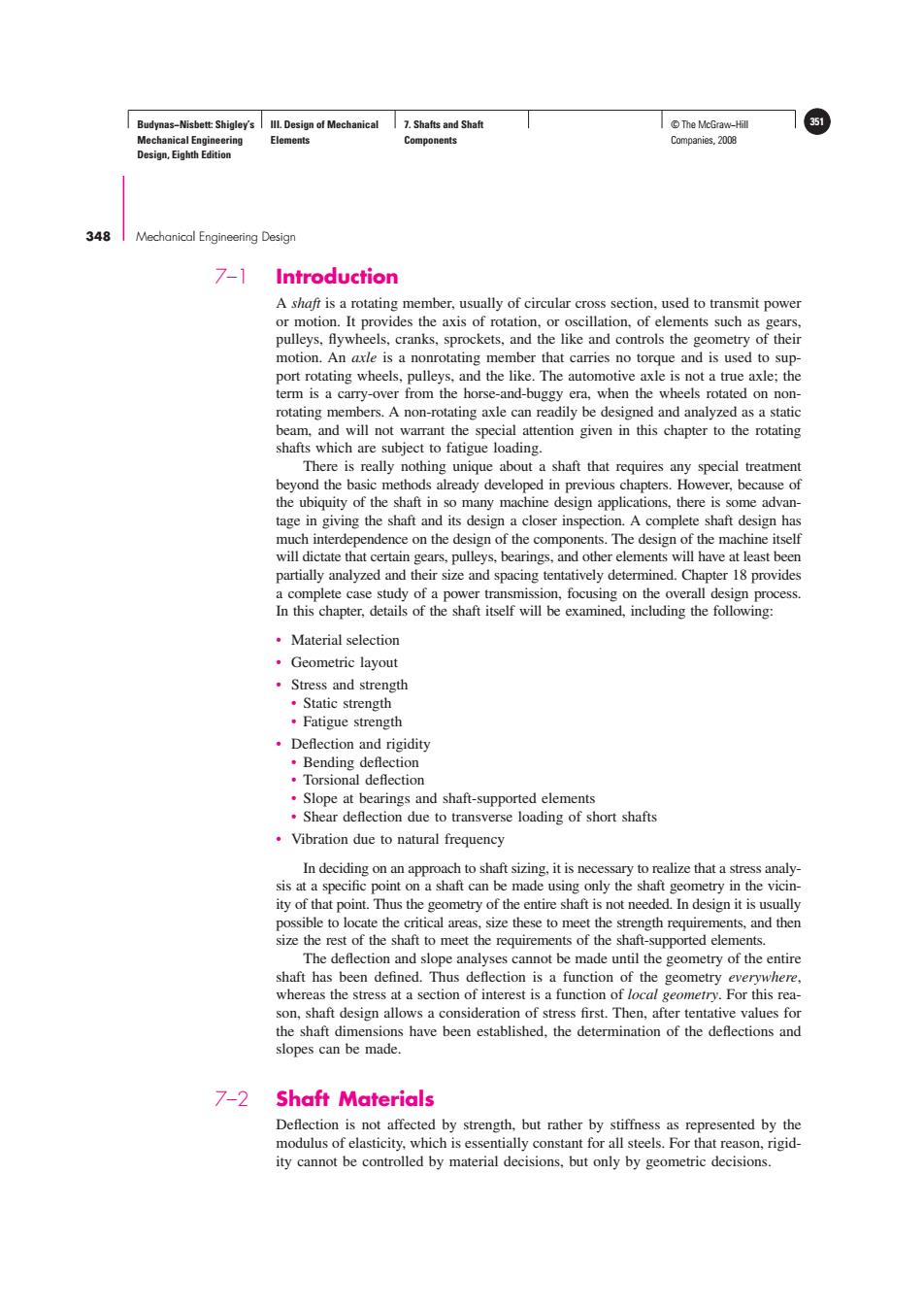正在加载图片...

Budynas-Nisbett:Shigley's Ill.Design of Mechanical 7.Shafts and Shaft T©The McGraw-Hill Mechanical Engineering Elements Components Companies,2008 Design,Eighth Edition 348 Mechanical Engineering Design 7-1 Introduction A shaft is a rotating member,usually of circular cross section,used to transmit power or motion.It provides the axis of rotation,or oscillation,of elements such as gears, pulleys,flywheels,cranks,sprockets,and the like and controls the geometry of their motion.An axle is a nonrotating member that carries no torque and is used to sup- port rotating wheels,pulleys,and the like.The automotive axle is not a true axle;the term is a carry-over from the horse-and-buggy era,when the wheels rotated on non- rotating members.A non-rotating axle can readily be designed and analyzed as a static beam,and will not warrant the special attention given in this chapter to the rotating shafts which are subject to fatigue loading. There is really nothing unique about a shaft that requires any special treatment beyond the basic methods already developed in previous chapters.However,because of the ubiquity of the shaft in so many machine design applications,there is some advan- tage in giving the shaft and its design a closer inspection.A complete shaft design has much interdependence on the design of the components.The design of the machine itself will dictate that certain gears,pulleys,bearings,and other elements will have at least been partially analyzed and their size and spacing tentatively determined.Chapter 18 provides a complete case study of a power transmission,focusing on the overall design process. In this chapter,details of the shaft itself will be examined,including the following: ·Material selection ·Geometric layout ·Stress and strength ·Static strength ·Fatigue strength Deflection and rigidity ·Bending deflection Torsional deflection Slope at bearings and shaft-supported elements Shear deflection due to transverse loading of short shafts Vibration due to natural frequency In deciding on an approach to shaft sizing,it is necessary to realize that a stress analy- sis at a specific point on a shaft can be made using only the shaft geometry in the vicin- ity of that point.Thus the geometry of the entire shaft is not needed.In design it is usually possible to locate the critical areas,size these to meet the strength requirements,and then size the rest of the shaft to meet the requirements of the shaft-supported elements. The deflection and slope analyses cannot be made until the geometry of the entire shaft has been defined.Thus deflection is a function of the geometry everywhere, whereas the stress at a section of interest is a function of local geometry.For this rea- son,shaft design allows a consideration of stress first.Then,after tentative values for the shaft dimensions have been established.the determination of the deflections and slopes can be made. 7-2 Shaft Materials Deflection is not affected by strength,but rather by stiffness as represented by the modulus of elasticity,which is essentially constant for all steels.For that reason,rigid- ity cannot be controlled by material decisions,but only by geometric decisions.Budynas−Nisbett: Shigley’s Mechanical Engineering Design, Eighth Edition III. Design of Mechanical Elements 7. Shafts and Shaft Components © The McGraw−Hill 351 Companies, 2008 348 Mechanical Engineering Design 7–1 Introduction A shaft is a rotating member, usually of circular cross section, used to transmit power or motion. It provides the axis of rotation, or oscillation, of elements such as gears, pulleys, flywheels, cranks, sprockets, and the like and controls the geometry of their motion. An axle is a nonrotating member that carries no torque and is used to support rotating wheels, pulleys, and the like. The automotive axle is not a true axle; the term is a carry-over from the horse-and-buggy era, when the wheels rotated on nonrotating members. A non-rotating axle can readily be designed and analyzed as a static beam, and will not warrant the special attention given in this chapter to the rotating shafts which are subject to fatigue loading. There is really nothing unique about a shaft that requires any special treatment beyond the basic methods already developed in previous chapters. However, because of the ubiquity of the shaft in so many machine design applications, there is some advantage in giving the shaft and its design a closer inspection. A complete shaft design has much interdependence on the design of the components. The design of the machine itself will dictate that certain gears, pulleys, bearings, and other elements will have at least been partially analyzed and their size and spacing tentatively determined. Chapter 18 provides a complete case study of a power transmission, focusing on the overall design process. In this chapter, details of the shaft itself will be examined, including the following: • Material selection • Geometric layout • Stress and strength • Static strength • Fatigue strength • Deflection and rigidity • Bending deflection • Torsional deflection • Slope at bearings and shaft-supported elements • Shear deflection due to transverse loading of short shafts • Vibration due to natural frequency In deciding on an approach to shaft sizing, it is necessary to realize that a stress analysis at a specific point on a shaft can be made using only the shaft geometry in the vicinity of that point. Thus the geometry of the entire shaft is not needed. In design it is usually possible to locate the critical areas, size these to meet the strength requirements, and then size the rest of the shaft to meet the requirements of the shaft-supported elements. The deflection and slope analyses cannot be made until the geometry of the entire shaft has been defined. Thus deflection is a function of the geometry everywhere, whereas the stress at a section of interest is a function of local geometry. For this reason, shaft design allows a consideration of stress first. Then, after tentative values for the shaft dimensions have been established, the determination of the deflections and slopes can be made. 7–2 Shaft Materials Deflection is not affected by strength, but rather by stiffness as represented by the modulus of elasticity, which is essentially constant for all steels. For that reason, rigidity cannot be controlled by material decisions, but only by geometric decisions